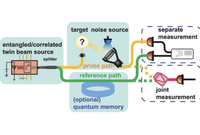Publication Date: March 6, 2025
Authors: Han Liu and Amr S Helmy
Abstract:
The goal of optical target detection is to identify the presence or absence of a target object by using light or photons as the transmitter. This technique offers significant advantages, such as high resolution and precise directionality, and plays a key role in applications like LiDAR. One of the critical performance metrics in optical target detection is noise resilience─specifically, the system’s ability to distinguish reflected signals from crosstalk or jamming sources with similar optical properties. Traditionally, this challenge has been addressed through classical information processing or standard optical filtering methods. However, a new approach to improving noise resilience has recently captured the attention of numerous researchers: harnessing the unique properties of quantum light sources. These sources offer performance enhancements that are challenging or even impossible to achieve with conventional coherent optical sources. In this perspective, we examine the performance and limitations of this emerging method, including challenges related to receiver complexity and power scaling. We also explore potential strategies to overcome these limitations, highlighting the practical advantages these approaches could offer.
Related links:
Read this publication on the ACS Photonics Website

